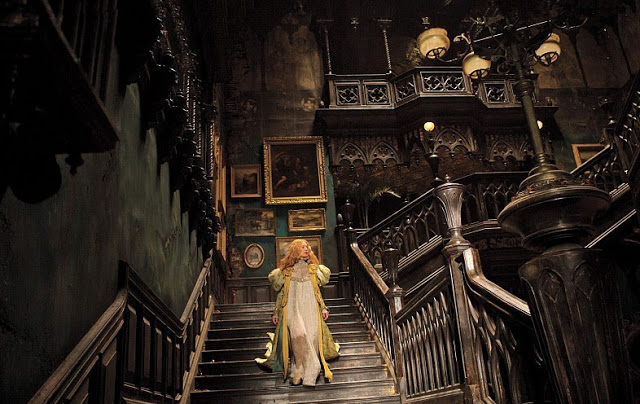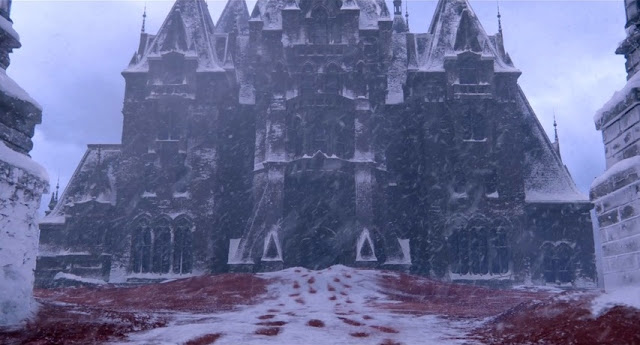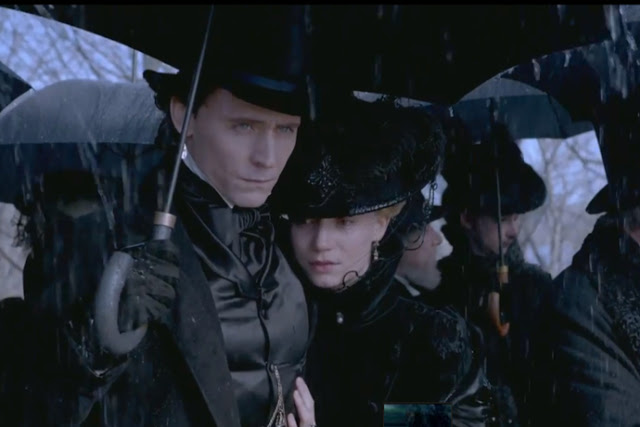Guillermo del Toro’s Crimson Peak is a frivolous, ravishing movie that invites a referendum on the very pleasures of moviegoing. This frustrating and satisfying film, which del Toro directed from a script he wrote with Matthew Robbins, is destined to divide audiences, not because it will elicit disputes over its quality, but because appreciation of it hinges entirely on the vagaries of subjective taste. Narrative purists who prioritize plotting and screenwriting above all else will doubtless be vexed by the clumsiness of its dialogue and the banality of its story. Formalists, however, will take rapture in its splendorous visuals and in the lush refinement of del Toro’s craft. It is, in binary terms, either a terrible good movie or a magnificent bad movie.
Let’s begin with the bad. From a storytelling standpoint, Crimson Peak is disappointingly rote, if not entirely dull. Set aside its fantastical prologue—in which a child is visited by the ghost of her newly dead mother, a black phantasm with spindly fingers who whispers gravely, “Beware of Crimson Peak”—and you might mistake it for a lavish period costume drama (if admittedly the first costume drama ever to take place in Buffalo). The year is 1891, and the object of attraction is the amusingly named Edith Cushing (Mia Wasikowska, persuasive as ever), the peculiar daughter of a pompous aristocrat, Carter (Deadwood‘s Jim Beaver). Edith is a bit like Cinderella without the wicked stepsiblings; she is mocked by the gentry for her oddness, even though she does draw the admiration of a handsome doctor (Charlie Hunnam, who headlined del Toro’s Pacific Rim). A classic Jane Austen heroine, Edith is unlucky in love but spirited in life, and she brazenly channels her energy into the masculine pursuit of fiction writing.
Her fortunes change, and drastically, when she literally bumps into Thomas Sharpe (Tom Hiddleston, trying his best), a smooth talker peddling a curious invention. Thomas, who is perpetually accompanied by his icy sister, Lucille (Jessica Chastain, adopting a cut-glass accent, as well as a healthy appetite for scenery), strikes out pitching his strange idea to Edith’s father, but he seems instantly smitten with this vivacious would-be novelist. It’s all very stiff—even accounting for the period setting, del Toro’s dialogue is heavily stilted—but at least it moves fast. Romance blooms, skulking misdeeds ensue (murder, she wrote!), and in a blink, Thomas and Edith are wed, and he’s whisking her across the pond, along with Lucille, to their family estate of Allerdale Hall.
And what an estate it is. A cross between Citizen Kane‘s Xanadu and the ruined castle from Beauty and the Beast, it has innumerable spires that jut into the chilly England air, along with countless wings and shadowy alcoves. But any filmmaker with a decent budget can create a mansion to rival that of Pemberley or Versailles. The majesty of Allerdale Hall is that it is at once grand and dilapidated. The house sits on dwindling deposits of red clay, the mining of which built the Sharpe fortune and the depletion of which now threatens to exhaust it. (Thomas’s invention is a radical attempt to automate the mining process and re-harness the land’s sacred ore.) The foundation has begun to sink into the ground itself, so that when Edith steps onto the lower-level floorboards, burgundy gunk oozes through the floor and seeps into her boots.
It is difficult to overstate the extraordinary care with which del Toro has concocted this haunted prison of ornamental rot. In strict genre terms, Crimson Peak is a ghost story, but the presence of wailing spirits isn’t the only reason Allerdale feels alive. Every room, every wall, every staircase possesses a looming sense of phantasmagorical menace. A bathtub creaks to life and then spits out rusty, blood-tinted water. A rickety elevator descends into a basement of dancing shadows and ominous sinkholes. Flames in fireplaces emit a hushed amber glow but no hint of actual warmth. And, in the movie’s greatest conceit, when the snow falls, it mingles with the submerged clay and turns a nightmarish shade of red, a phenomenon that suggests bleeding and that, Edith learns (too late!), has led the locals to dub the estate “Crimson Peak”.
Sacre bleu! But don’t fret. As sumptuously foreboding as Crimson Peak‘s production design may be—a quality echoed by Dan Laustsen’s gorgeous cinematography—the movie itself is not especially scary. This is not necessarily a criticism; many bad horror films shrilly terrorize their audience through brute force as a means of disguising their lack of substance. Thankfully, Del Toro is too classical and painterly a filmmaker to stoop to reliance on the jump-scare. At the same time, Crimson Peak‘s seductive beauty eventually feels like its own form of camouflage, a sly smokescreen designed to conceal the cavernous emptiness at its center. There is so much to see here, yet so little of interest that actually takes place, and del Toro proves himself a far better director than a screenwriter. Just because the house groans doesn’t mean the story needs to.
Or perhaps the ordinariness of Edith’s plight simply feels unworthy of the luxuriant setting in which it takes place. Even if the arc of Crimson Peak feels thoroughly familiar—poisons, dead bodies, buried secrets, the works—there is a certain pleasure in watching Edith uncover the dark conspiracy enveloping her, possibly because Wasikowska remains a remarkably sympathetic screen presence. And if a late reveal feels half-predictable, half-inconsequential, it nevertheless allows for the sight of Chastain snarling her way through the film’s final act, a fairly tedious exercise of hide-and-seek-and-slash with an unconvincing spiritual tint.
But just as exalting Crimson Peak‘s marvelous atmosphere ignores its shallow logic, focusing on its narrative shortcomings paints an incomplete picture. It must be viewed in total, the beautiful alongside the banal. Horror fans will undoubtedly compare it to The Shining, another haunted-house tale of snow-capped madness. And any film del Toro makes for the rest of his career will be measured (unfavorably) against Pan’s Labyrinth, his magnum opus that brilliantly fused childhood fantasy with real-world terror. (Doug Jones, who played the iconic Pale Man in that film, is credited here as Edith’s spectral mother.) Yet the most apt comparison may be Michael Mann’s Miami Vice. In that film, Mann used his immense talents to elevate a glum police procedural into a stunning work of poetic and visual art. And here, del Toro consciously sacrifices basic storytelling values—plot, character, suspense—in the service of something grander and more operatic. That’s why Crimson Peak is somehow a flimsy piece of low entertainment that, at the same time, constitutes movie-making at its absolute zenith.
Jeremy Beck is the editor-in-chief of MovieManifesto. He watches more movies and television than he probably should.



